Comprehensive Report on Managing Human Resource Effectively
VerifiedAdded on 2020/10/05
|11
|3322
|436
Report
AI Summary
This report delves into the realm of human resource management, focusing on the traditional interview method as a key element in the recruitment and selection process. It outlines the steps involved in traditional interviews, from screening and phone interviews to face-to-face and final interviews, highlighting their structure and objectives. The report evaluates the effectiveness of this method in selecting high-quality candidates and its impact on predictive validity. It further explores the concept of predictive validity in the context of pre-employment testing and how to enhance it within the interview process. The analysis emphasizes the importance of structured interviews, quantitative research, and avoiding biases to improve the reliability of candidate assessments and achieve better outcomes in employee selection.
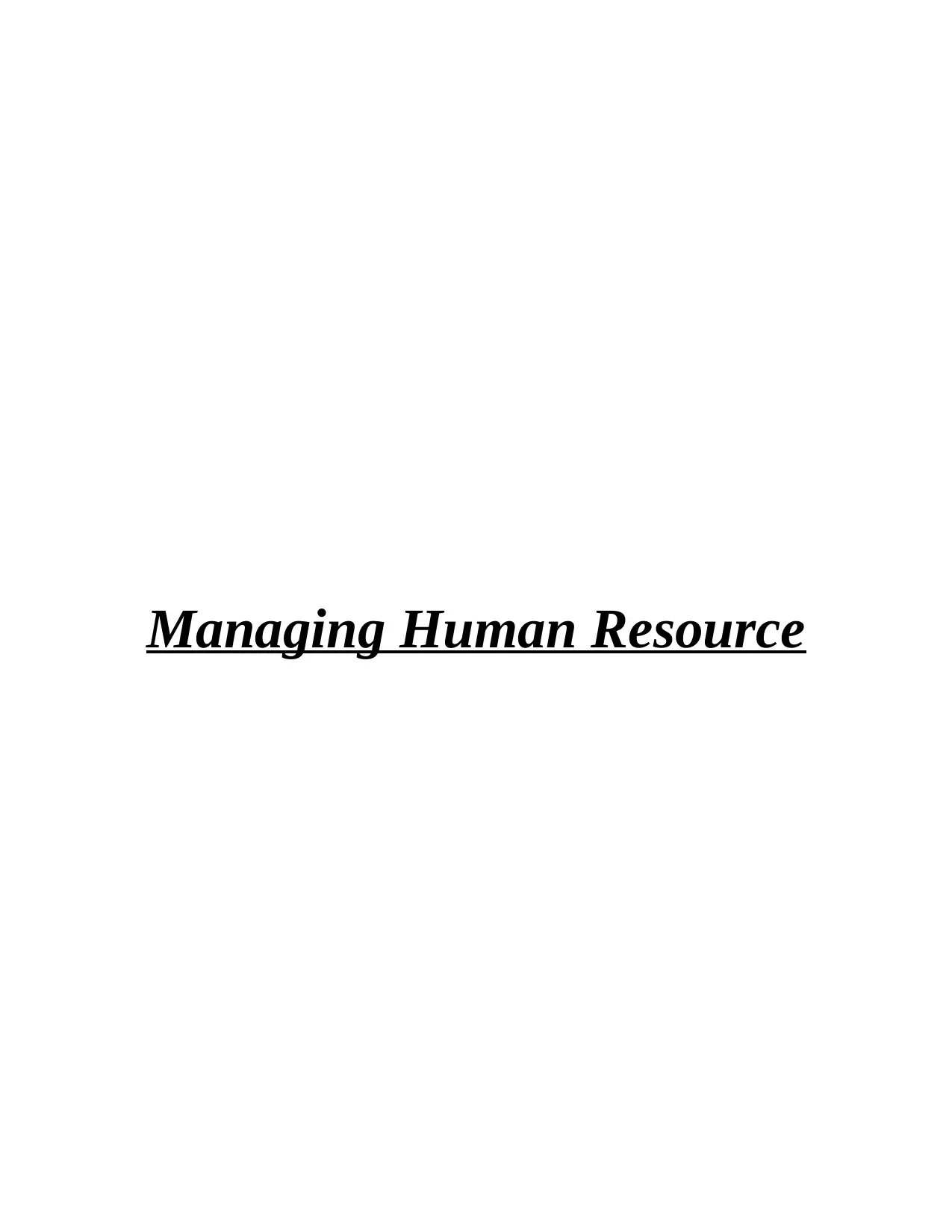
Managing Human Resource
Paraphrase This Document
Need a fresh take? Get an instant paraphrase of this document with our AI Paraphraser
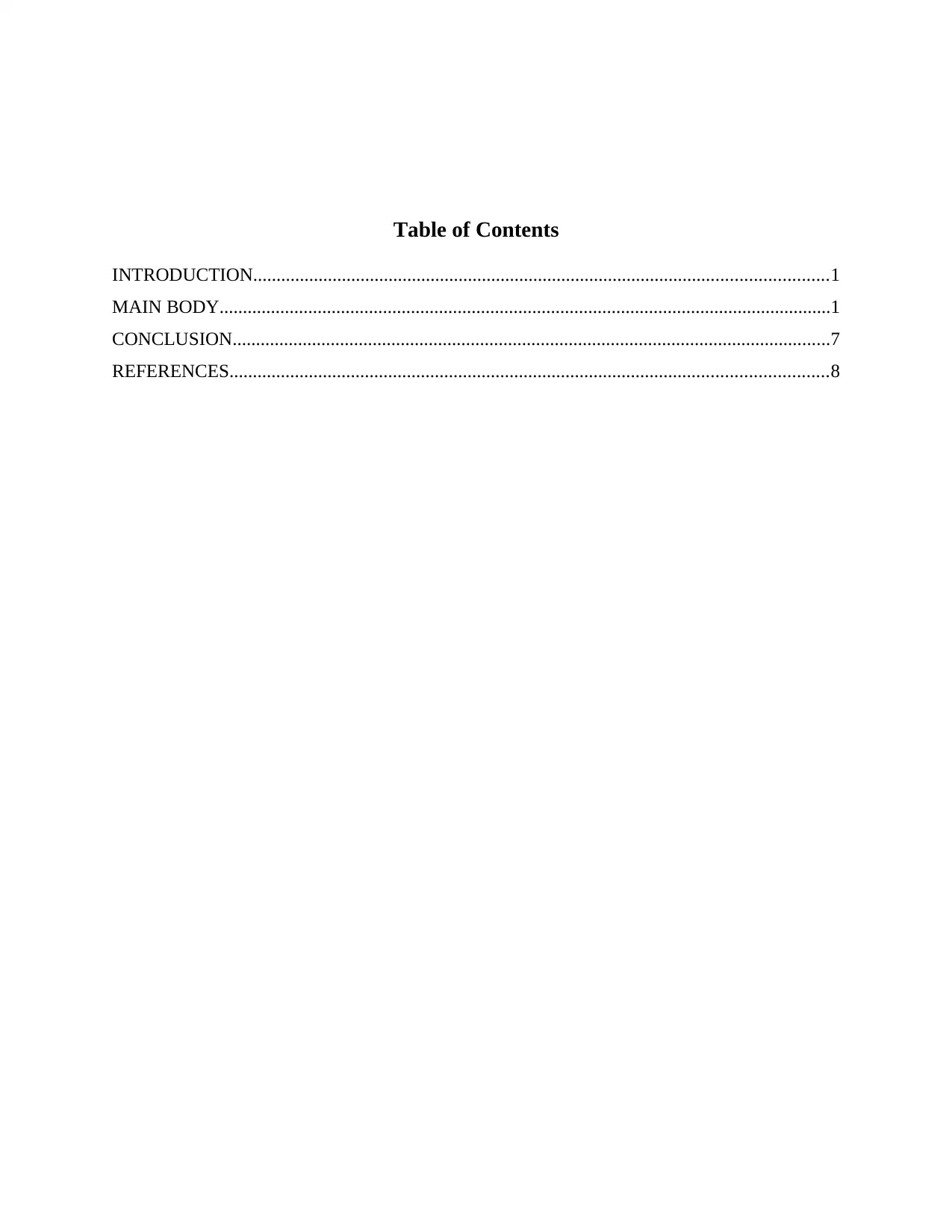
Table of Contents
INTRODUCTION...........................................................................................................................1
MAIN BODY...................................................................................................................................1
CONCLUSION................................................................................................................................7
REFERENCES................................................................................................................................8
INTRODUCTION...........................................................................................................................1
MAIN BODY...................................................................................................................................1
CONCLUSION................................................................................................................................7
REFERENCES................................................................................................................................8

⊘ This is a preview!⊘
Do you want full access?
Subscribe today to unlock all pages.

Trusted by 1+ million students worldwide
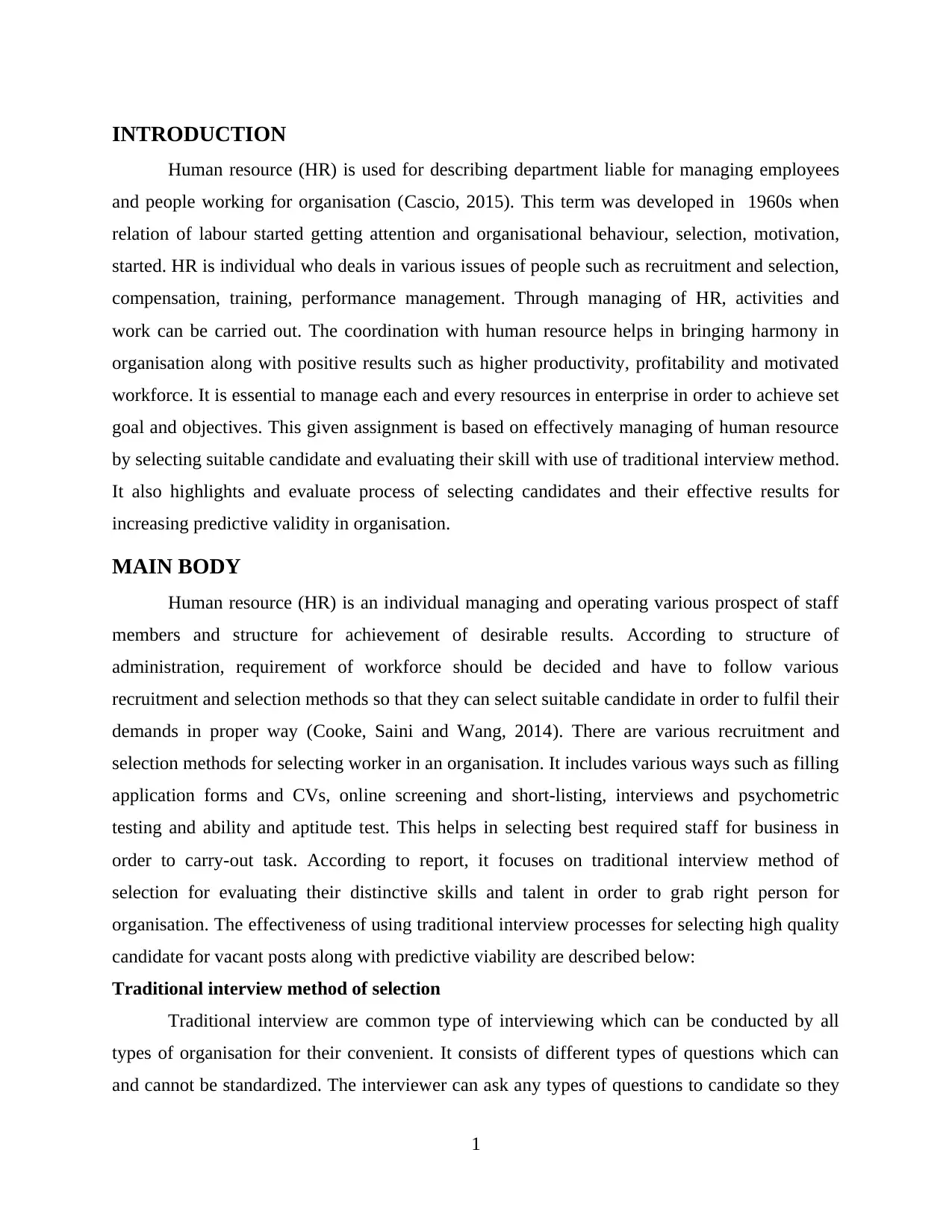
INTRODUCTION
Human resource (HR) is used for describing department liable for managing employees
and people working for organisation (Cascio, 2015). This term was developed in 1960s when
relation of labour started getting attention and organisational behaviour, selection, motivation,
started. HR is individual who deals in various issues of people such as recruitment and selection,
compensation, training, performance management. Through managing of HR, activities and
work can be carried out. The coordination with human resource helps in bringing harmony in
organisation along with positive results such as higher productivity, profitability and motivated
workforce. It is essential to manage each and every resources in enterprise in order to achieve set
goal and objectives. This given assignment is based on effectively managing of human resource
by selecting suitable candidate and evaluating their skill with use of traditional interview method.
It also highlights and evaluate process of selecting candidates and their effective results for
increasing predictive validity in organisation.
MAIN BODY
Human resource (HR) is an individual managing and operating various prospect of staff
members and structure for achievement of desirable results. According to structure of
administration, requirement of workforce should be decided and have to follow various
recruitment and selection methods so that they can select suitable candidate in order to fulfil their
demands in proper way (Cooke, Saini and Wang, 2014). There are various recruitment and
selection methods for selecting worker in an organisation. It includes various ways such as filling
application forms and CVs, online screening and short-listing, interviews and psychometric
testing and ability and aptitude test. This helps in selecting best required staff for business in
order to carry-out task. According to report, it focuses on traditional interview method of
selection for evaluating their distinctive skills and talent in order to grab right person for
organisation. The effectiveness of using traditional interview processes for selecting high quality
candidate for vacant posts along with predictive viability are described below:
Traditional interview method of selection
Traditional interview are common type of interviewing which can be conducted by all
types of organisation for their convenient. It consists of different types of questions which can
and cannot be standardized. The interviewer can ask any types of questions to candidate so they
1
Human resource (HR) is used for describing department liable for managing employees
and people working for organisation (Cascio, 2015). This term was developed in 1960s when
relation of labour started getting attention and organisational behaviour, selection, motivation,
started. HR is individual who deals in various issues of people such as recruitment and selection,
compensation, training, performance management. Through managing of HR, activities and
work can be carried out. The coordination with human resource helps in bringing harmony in
organisation along with positive results such as higher productivity, profitability and motivated
workforce. It is essential to manage each and every resources in enterprise in order to achieve set
goal and objectives. This given assignment is based on effectively managing of human resource
by selecting suitable candidate and evaluating their skill with use of traditional interview method.
It also highlights and evaluate process of selecting candidates and their effective results for
increasing predictive validity in organisation.
MAIN BODY
Human resource (HR) is an individual managing and operating various prospect of staff
members and structure for achievement of desirable results. According to structure of
administration, requirement of workforce should be decided and have to follow various
recruitment and selection methods so that they can select suitable candidate in order to fulfil their
demands in proper way (Cooke, Saini and Wang, 2014). There are various recruitment and
selection methods for selecting worker in an organisation. It includes various ways such as filling
application forms and CVs, online screening and short-listing, interviews and psychometric
testing and ability and aptitude test. This helps in selecting best required staff for business in
order to carry-out task. According to report, it focuses on traditional interview method of
selection for evaluating their distinctive skills and talent in order to grab right person for
organisation. The effectiveness of using traditional interview processes for selecting high quality
candidate for vacant posts along with predictive viability are described below:
Traditional interview method of selection
Traditional interview are common type of interviewing which can be conducted by all
types of organisation for their convenient. It consists of different types of questions which can
and cannot be standardized. The interviewer can ask any types of questions to candidate so they
1
Paraphrase This Document
Need a fresh take? Get an instant paraphrase of this document with our AI Paraphraser
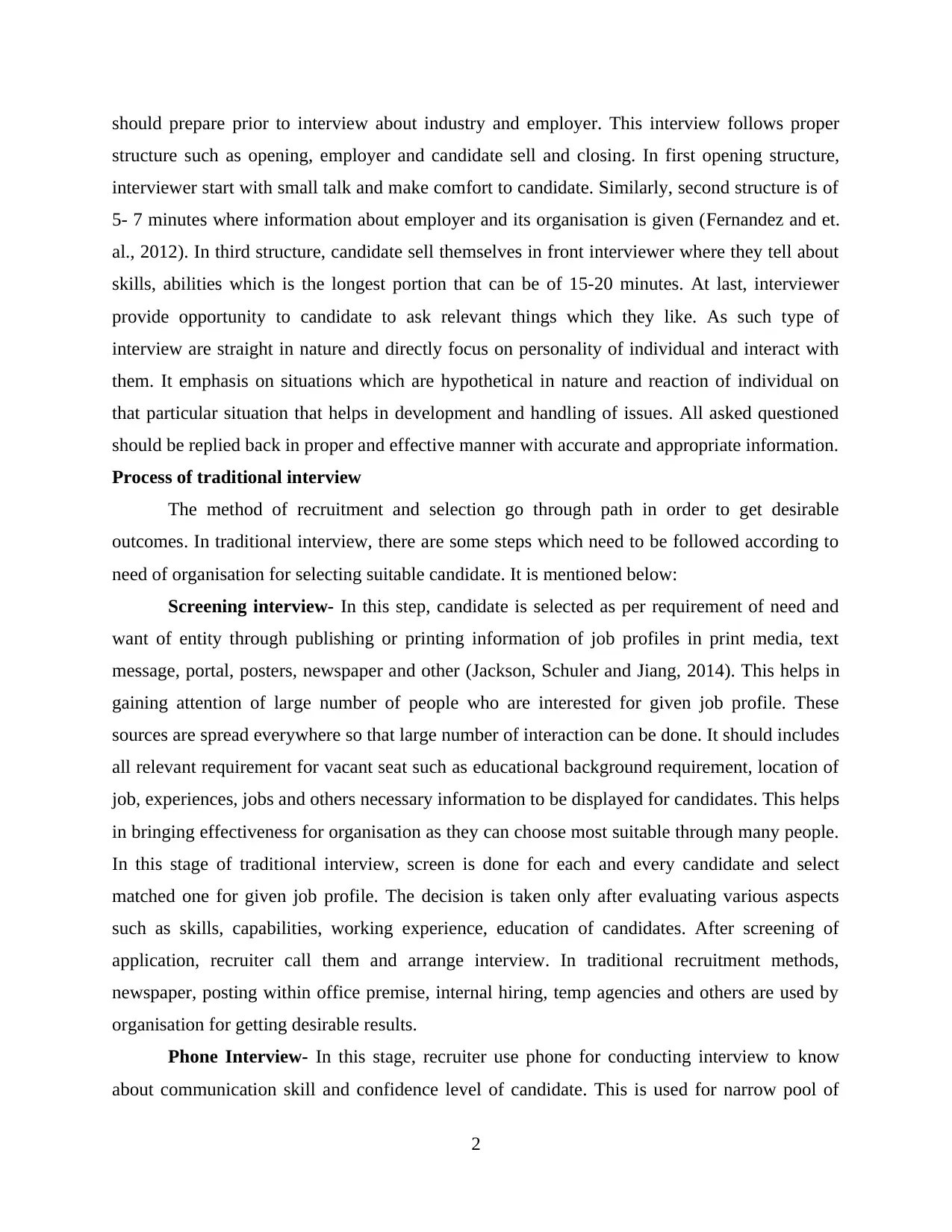
should prepare prior to interview about industry and employer. This interview follows proper
structure such as opening, employer and candidate sell and closing. In first opening structure,
interviewer start with small talk and make comfort to candidate. Similarly, second structure is of
5- 7 minutes where information about employer and its organisation is given (Fernandez and et.
al., 2012). In third structure, candidate sell themselves in front interviewer where they tell about
skills, abilities which is the longest portion that can be of 15-20 minutes. At last, interviewer
provide opportunity to candidate to ask relevant things which they like. As such type of
interview are straight in nature and directly focus on personality of individual and interact with
them. It emphasis on situations which are hypothetical in nature and reaction of individual on
that particular situation that helps in development and handling of issues. All asked questioned
should be replied back in proper and effective manner with accurate and appropriate information.
Process of traditional interview
The method of recruitment and selection go through path in order to get desirable
outcomes. In traditional interview, there are some steps which need to be followed according to
need of organisation for selecting suitable candidate. It is mentioned below:
Screening interview- In this step, candidate is selected as per requirement of need and
want of entity through publishing or printing information of job profiles in print media, text
message, portal, posters, newspaper and other (Jackson, Schuler and Jiang, 2014). This helps in
gaining attention of large number of people who are interested for given job profile. These
sources are spread everywhere so that large number of interaction can be done. It should includes
all relevant requirement for vacant seat such as educational background requirement, location of
job, experiences, jobs and others necessary information to be displayed for candidates. This helps
in bringing effectiveness for organisation as they can choose most suitable through many people.
In this stage of traditional interview, screen is done for each and every candidate and select
matched one for given job profile. The decision is taken only after evaluating various aspects
such as skills, capabilities, working experience, education of candidates. After screening of
application, recruiter call them and arrange interview. In traditional recruitment methods,
newspaper, posting within office premise, internal hiring, temp agencies and others are used by
organisation for getting desirable results.
Phone Interview- In this stage, recruiter use phone for conducting interview to know
about communication skill and confidence level of candidate. This is used for narrow pool of
2
structure such as opening, employer and candidate sell and closing. In first opening structure,
interviewer start with small talk and make comfort to candidate. Similarly, second structure is of
5- 7 minutes where information about employer and its organisation is given (Fernandez and et.
al., 2012). In third structure, candidate sell themselves in front interviewer where they tell about
skills, abilities which is the longest portion that can be of 15-20 minutes. At last, interviewer
provide opportunity to candidate to ask relevant things which they like. As such type of
interview are straight in nature and directly focus on personality of individual and interact with
them. It emphasis on situations which are hypothetical in nature and reaction of individual on
that particular situation that helps in development and handling of issues. All asked questioned
should be replied back in proper and effective manner with accurate and appropriate information.
Process of traditional interview
The method of recruitment and selection go through path in order to get desirable
outcomes. In traditional interview, there are some steps which need to be followed according to
need of organisation for selecting suitable candidate. It is mentioned below:
Screening interview- In this step, candidate is selected as per requirement of need and
want of entity through publishing or printing information of job profiles in print media, text
message, portal, posters, newspaper and other (Jackson, Schuler and Jiang, 2014). This helps in
gaining attention of large number of people who are interested for given job profile. These
sources are spread everywhere so that large number of interaction can be done. It should includes
all relevant requirement for vacant seat such as educational background requirement, location of
job, experiences, jobs and others necessary information to be displayed for candidates. This helps
in bringing effectiveness for organisation as they can choose most suitable through many people.
In this stage of traditional interview, screen is done for each and every candidate and select
matched one for given job profile. The decision is taken only after evaluating various aspects
such as skills, capabilities, working experience, education of candidates. After screening of
application, recruiter call them and arrange interview. In traditional recruitment methods,
newspaper, posting within office premise, internal hiring, temp agencies and others are used by
organisation for getting desirable results.
Phone Interview- In this stage, recruiter use phone for conducting interview to know
about communication skill and confidence level of candidate. This is used for narrow pool of
2
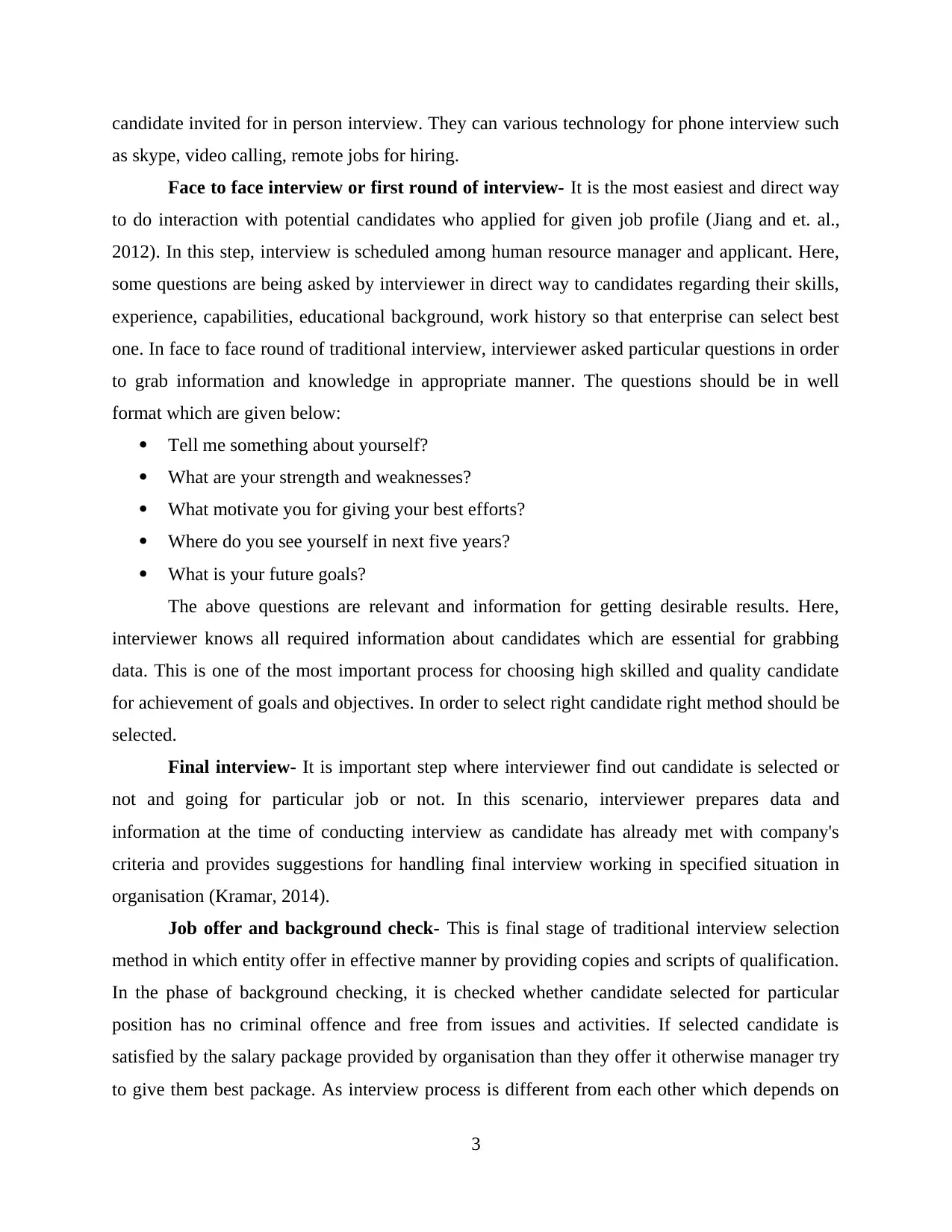
candidate invited for in person interview. They can various technology for phone interview such
as skype, video calling, remote jobs for hiring.
Face to face interview or first round of interview- It is the most easiest and direct way
to do interaction with potential candidates who applied for given job profile (Jiang and et. al.,
2012). In this step, interview is scheduled among human resource manager and applicant. Here,
some questions are being asked by interviewer in direct way to candidates regarding their skills,
experience, capabilities, educational background, work history so that enterprise can select best
one. In face to face round of traditional interview, interviewer asked particular questions in order
to grab information and knowledge in appropriate manner. The questions should be in well
format which are given below:
Tell me something about yourself?
What are your strength and weaknesses?
What motivate you for giving your best efforts?
Where do you see yourself in next five years?
What is your future goals?
The above questions are relevant and information for getting desirable results. Here,
interviewer knows all required information about candidates which are essential for grabbing
data. This is one of the most important process for choosing high skilled and quality candidate
for achievement of goals and objectives. In order to select right candidate right method should be
selected.
Final interview- It is important step where interviewer find out candidate is selected or
not and going for particular job or not. In this scenario, interviewer prepares data and
information at the time of conducting interview as candidate has already met with company's
criteria and provides suggestions for handling final interview working in specified situation in
organisation (Kramar, 2014).
Job offer and background check- This is final stage of traditional interview selection
method in which entity offer in effective manner by providing copies and scripts of qualification.
In the phase of background checking, it is checked whether candidate selected for particular
position has no criminal offence and free from issues and activities. If selected candidate is
satisfied by the salary package provided by organisation than they offer it otherwise manager try
to give them best package. As interview process is different from each other which depends on
3
as skype, video calling, remote jobs for hiring.
Face to face interview or first round of interview- It is the most easiest and direct way
to do interaction with potential candidates who applied for given job profile (Jiang and et. al.,
2012). In this step, interview is scheduled among human resource manager and applicant. Here,
some questions are being asked by interviewer in direct way to candidates regarding their skills,
experience, capabilities, educational background, work history so that enterprise can select best
one. In face to face round of traditional interview, interviewer asked particular questions in order
to grab information and knowledge in appropriate manner. The questions should be in well
format which are given below:
Tell me something about yourself?
What are your strength and weaknesses?
What motivate you for giving your best efforts?
Where do you see yourself in next five years?
What is your future goals?
The above questions are relevant and information for getting desirable results. Here,
interviewer knows all required information about candidates which are essential for grabbing
data. This is one of the most important process for choosing high skilled and quality candidate
for achievement of goals and objectives. In order to select right candidate right method should be
selected.
Final interview- It is important step where interviewer find out candidate is selected or
not and going for particular job or not. In this scenario, interviewer prepares data and
information at the time of conducting interview as candidate has already met with company's
criteria and provides suggestions for handling final interview working in specified situation in
organisation (Kramar, 2014).
Job offer and background check- This is final stage of traditional interview selection
method in which entity offer in effective manner by providing copies and scripts of qualification.
In the phase of background checking, it is checked whether candidate selected for particular
position has no criminal offence and free from issues and activities. If selected candidate is
satisfied by the salary package provided by organisation than they offer it otherwise manager try
to give them best package. As interview process is different from each other which depends on
3
⊘ This is a preview!⊘
Do you want full access?
Subscribe today to unlock all pages.

Trusted by 1+ million students worldwide
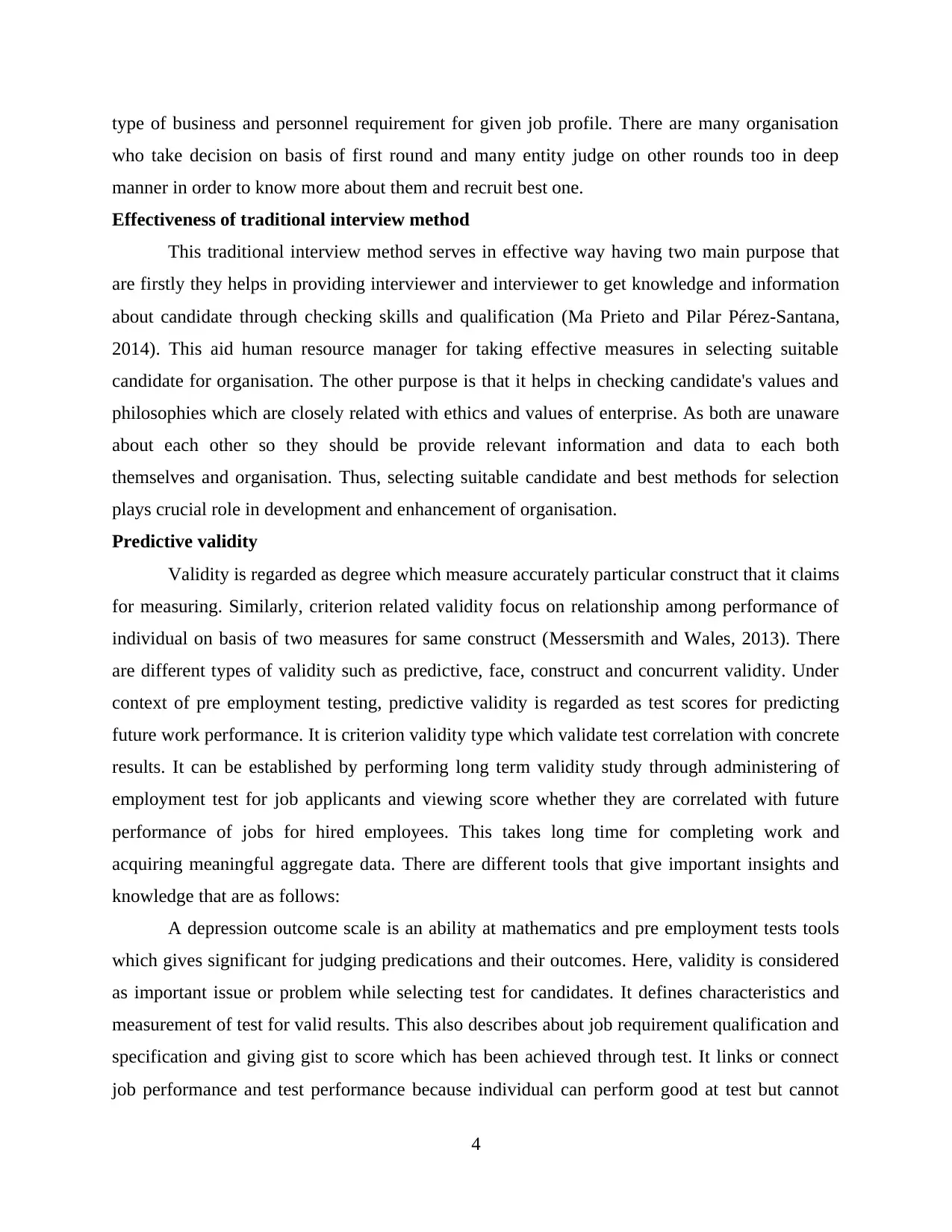
type of business and personnel requirement for given job profile. There are many organisation
who take decision on basis of first round and many entity judge on other rounds too in deep
manner in order to know more about them and recruit best one.
Effectiveness of traditional interview method
This traditional interview method serves in effective way having two main purpose that
are firstly they helps in providing interviewer and interviewer to get knowledge and information
about candidate through checking skills and qualification (Ma Prieto and Pilar Pérez-Santana,
2014). This aid human resource manager for taking effective measures in selecting suitable
candidate for organisation. The other purpose is that it helps in checking candidate's values and
philosophies which are closely related with ethics and values of enterprise. As both are unaware
about each other so they should be provide relevant information and data to each both
themselves and organisation. Thus, selecting suitable candidate and best methods for selection
plays crucial role in development and enhancement of organisation.
Predictive validity
Validity is regarded as degree which measure accurately particular construct that it claims
for measuring. Similarly, criterion related validity focus on relationship among performance of
individual on basis of two measures for same construct (Messersmith and Wales, 2013). There
are different types of validity such as predictive, face, construct and concurrent validity. Under
context of pre employment testing, predictive validity is regarded as test scores for predicting
future work performance. It is criterion validity type which validate test correlation with concrete
results. It can be established by performing long term validity study through administering of
employment test for job applicants and viewing score whether they are correlated with future
performance of jobs for hired employees. This takes long time for completing work and
acquiring meaningful aggregate data. There are different tools that give important insights and
knowledge that are as follows:
A depression outcome scale is an ability at mathematics and pre employment tests tools
which gives significant for judging predications and their outcomes. Here, validity is considered
as important issue or problem while selecting test for candidates. It defines characteristics and
measurement of test for valid results. This also describes about job requirement qualification and
specification and giving gist to score which has been achieved through test. It links or connect
job performance and test performance because individual can perform good at test but cannot
4
who take decision on basis of first round and many entity judge on other rounds too in deep
manner in order to know more about them and recruit best one.
Effectiveness of traditional interview method
This traditional interview method serves in effective way having two main purpose that
are firstly they helps in providing interviewer and interviewer to get knowledge and information
about candidate through checking skills and qualification (Ma Prieto and Pilar Pérez-Santana,
2014). This aid human resource manager for taking effective measures in selecting suitable
candidate for organisation. The other purpose is that it helps in checking candidate's values and
philosophies which are closely related with ethics and values of enterprise. As both are unaware
about each other so they should be provide relevant information and data to each both
themselves and organisation. Thus, selecting suitable candidate and best methods for selection
plays crucial role in development and enhancement of organisation.
Predictive validity
Validity is regarded as degree which measure accurately particular construct that it claims
for measuring. Similarly, criterion related validity focus on relationship among performance of
individual on basis of two measures for same construct (Messersmith and Wales, 2013). There
are different types of validity such as predictive, face, construct and concurrent validity. Under
context of pre employment testing, predictive validity is regarded as test scores for predicting
future work performance. It is criterion validity type which validate test correlation with concrete
results. It can be established by performing long term validity study through administering of
employment test for job applicants and viewing score whether they are correlated with future
performance of jobs for hired employees. This takes long time for completing work and
acquiring meaningful aggregate data. There are different tools that give important insights and
knowledge that are as follows:
A depression outcome scale is an ability at mathematics and pre employment tests tools
which gives significant for judging predications and their outcomes. Here, validity is considered
as important issue or problem while selecting test for candidates. It defines characteristics and
measurement of test for valid results. This also describes about job requirement qualification and
specification and giving gist to score which has been achieved through test. It links or connect
job performance and test performance because individual can perform good at test but cannot
4
Paraphrase This Document
Need a fresh take? Get an instant paraphrase of this document with our AI Paraphraser
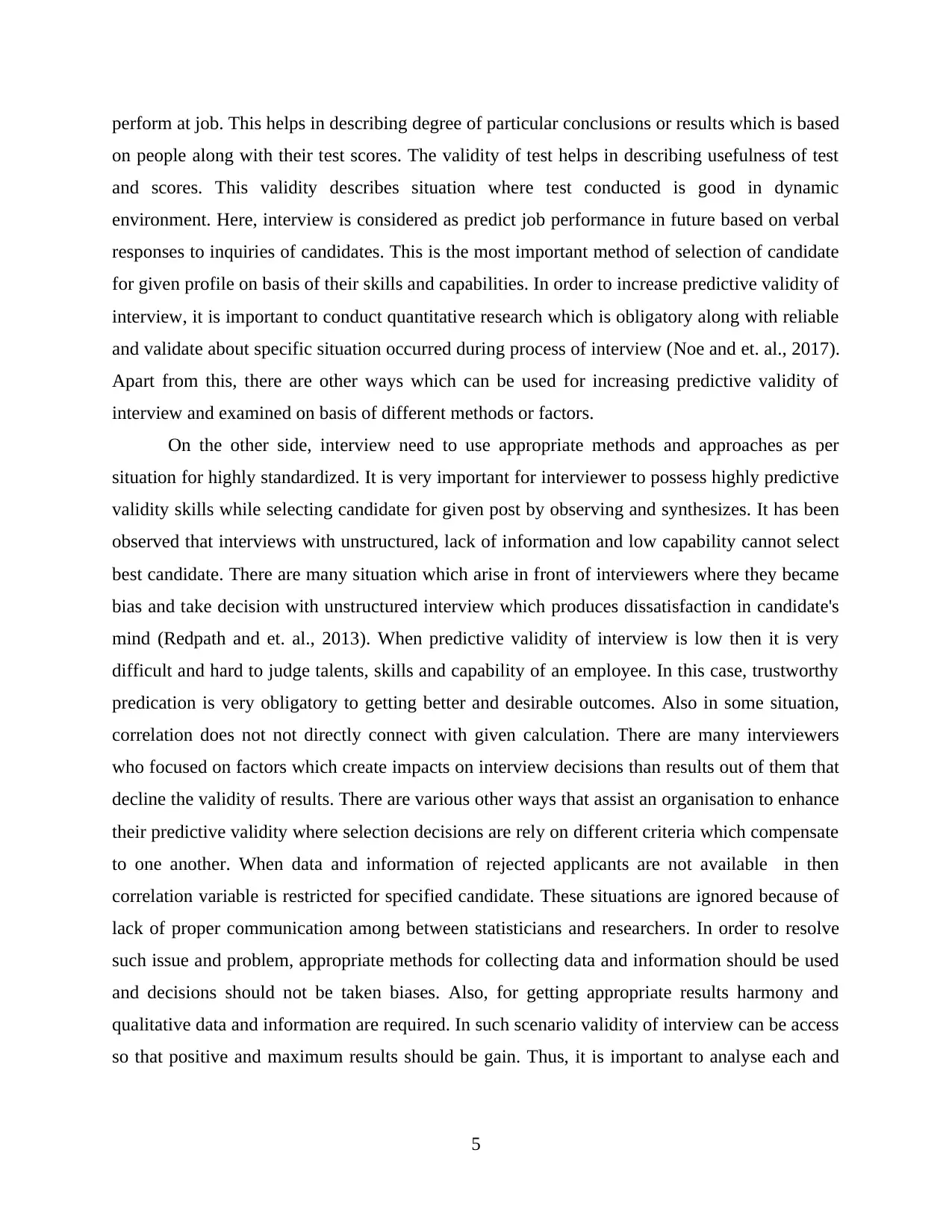
perform at job. This helps in describing degree of particular conclusions or results which is based
on people along with their test scores. The validity of test helps in describing usefulness of test
and scores. This validity describes situation where test conducted is good in dynamic
environment. Here, interview is considered as predict job performance in future based on verbal
responses to inquiries of candidates. This is the most important method of selection of candidate
for given profile on basis of their skills and capabilities. In order to increase predictive validity of
interview, it is important to conduct quantitative research which is obligatory along with reliable
and validate about specific situation occurred during process of interview (Noe and et. al., 2017).
Apart from this, there are other ways which can be used for increasing predictive validity of
interview and examined on basis of different methods or factors.
On the other side, interview need to use appropriate methods and approaches as per
situation for highly standardized. It is very important for interviewer to possess highly predictive
validity skills while selecting candidate for given post by observing and synthesizes. It has been
observed that interviews with unstructured, lack of information and low capability cannot select
best candidate. There are many situation which arise in front of interviewers where they became
bias and take decision with unstructured interview which produces dissatisfaction in candidate's
mind (Redpath and et. al., 2013). When predictive validity of interview is low then it is very
difficult and hard to judge talents, skills and capability of an employee. In this case, trustworthy
predication is very obligatory to getting better and desirable outcomes. Also in some situation,
correlation does not not directly connect with given calculation. There are many interviewers
who focused on factors which create impacts on interview decisions than results out of them that
decline the validity of results. There are various other ways that assist an organisation to enhance
their predictive validity where selection decisions are rely on different criteria which compensate
to one another. When data and information of rejected applicants are not available in then
correlation variable is restricted for specified candidate. These situations are ignored because of
lack of proper communication among between statisticians and researchers. In order to resolve
such issue and problem, appropriate methods for collecting data and information should be used
and decisions should not be taken biases. Also, for getting appropriate results harmony and
qualitative data and information are required. In such scenario validity of interview can be access
so that positive and maximum results should be gain. Thus, it is important to analyse each and
5
on people along with their test scores. The validity of test helps in describing usefulness of test
and scores. This validity describes situation where test conducted is good in dynamic
environment. Here, interview is considered as predict job performance in future based on verbal
responses to inquiries of candidates. This is the most important method of selection of candidate
for given profile on basis of their skills and capabilities. In order to increase predictive validity of
interview, it is important to conduct quantitative research which is obligatory along with reliable
and validate about specific situation occurred during process of interview (Noe and et. al., 2017).
Apart from this, there are other ways which can be used for increasing predictive validity of
interview and examined on basis of different methods or factors.
On the other side, interview need to use appropriate methods and approaches as per
situation for highly standardized. It is very important for interviewer to possess highly predictive
validity skills while selecting candidate for given post by observing and synthesizes. It has been
observed that interviews with unstructured, lack of information and low capability cannot select
best candidate. There are many situation which arise in front of interviewers where they became
bias and take decision with unstructured interview which produces dissatisfaction in candidate's
mind (Redpath and et. al., 2013). When predictive validity of interview is low then it is very
difficult and hard to judge talents, skills and capability of an employee. In this case, trustworthy
predication is very obligatory to getting better and desirable outcomes. Also in some situation,
correlation does not not directly connect with given calculation. There are many interviewers
who focused on factors which create impacts on interview decisions than results out of them that
decline the validity of results. There are various other ways that assist an organisation to enhance
their predictive validity where selection decisions are rely on different criteria which compensate
to one another. When data and information of rejected applicants are not available in then
correlation variable is restricted for specified candidate. These situations are ignored because of
lack of proper communication among between statisticians and researchers. In order to resolve
such issue and problem, appropriate methods for collecting data and information should be used
and decisions should not be taken biases. Also, for getting appropriate results harmony and
qualitative data and information are required. In such scenario validity of interview can be access
so that positive and maximum results should be gain. Thus, it is important to analyse each and
5
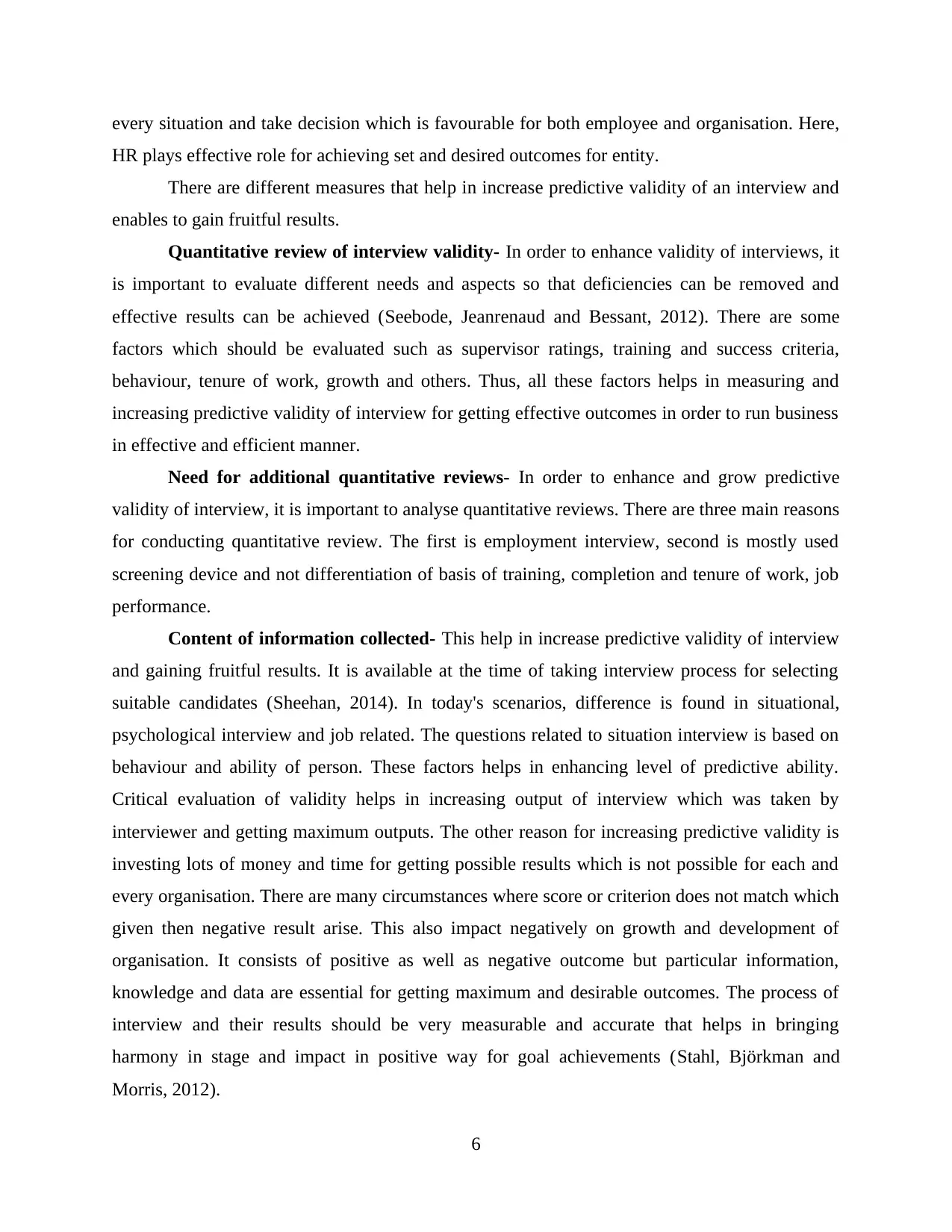
every situation and take decision which is favourable for both employee and organisation. Here,
HR plays effective role for achieving set and desired outcomes for entity.
There are different measures that help in increase predictive validity of an interview and
enables to gain fruitful results.
Quantitative review of interview validity- In order to enhance validity of interviews, it
is important to evaluate different needs and aspects so that deficiencies can be removed and
effective results can be achieved (Seebode, Jeanrenaud and Bessant, 2012). There are some
factors which should be evaluated such as supervisor ratings, training and success criteria,
behaviour, tenure of work, growth and others. Thus, all these factors helps in measuring and
increasing predictive validity of interview for getting effective outcomes in order to run business
in effective and efficient manner.
Need for additional quantitative reviews- In order to enhance and grow predictive
validity of interview, it is important to analyse quantitative reviews. There are three main reasons
for conducting quantitative review. The first is employment interview, second is mostly used
screening device and not differentiation of basis of training, completion and tenure of work, job
performance.
Content of information collected- This help in increase predictive validity of interview
and gaining fruitful results. It is available at the time of taking interview process for selecting
suitable candidates (Sheehan, 2014). In today's scenarios, difference is found in situational,
psychological interview and job related. The questions related to situation interview is based on
behaviour and ability of person. These factors helps in enhancing level of predictive ability.
Critical evaluation of validity helps in increasing output of interview which was taken by
interviewer and getting maximum outputs. The other reason for increasing predictive validity is
investing lots of money and time for getting possible results which is not possible for each and
every organisation. There are many circumstances where score or criterion does not match which
given then negative result arise. This also impact negatively on growth and development of
organisation. It consists of positive as well as negative outcome but particular information,
knowledge and data are essential for getting maximum and desirable outcomes. The process of
interview and their results should be very measurable and accurate that helps in bringing
harmony in stage and impact in positive way for goal achievements (Stahl, Björkman and
Morris, 2012).
6
HR plays effective role for achieving set and desired outcomes for entity.
There are different measures that help in increase predictive validity of an interview and
enables to gain fruitful results.
Quantitative review of interview validity- In order to enhance validity of interviews, it
is important to evaluate different needs and aspects so that deficiencies can be removed and
effective results can be achieved (Seebode, Jeanrenaud and Bessant, 2012). There are some
factors which should be evaluated such as supervisor ratings, training and success criteria,
behaviour, tenure of work, growth and others. Thus, all these factors helps in measuring and
increasing predictive validity of interview for getting effective outcomes in order to run business
in effective and efficient manner.
Need for additional quantitative reviews- In order to enhance and grow predictive
validity of interview, it is important to analyse quantitative reviews. There are three main reasons
for conducting quantitative review. The first is employment interview, second is mostly used
screening device and not differentiation of basis of training, completion and tenure of work, job
performance.
Content of information collected- This help in increase predictive validity of interview
and gaining fruitful results. It is available at the time of taking interview process for selecting
suitable candidates (Sheehan, 2014). In today's scenarios, difference is found in situational,
psychological interview and job related. The questions related to situation interview is based on
behaviour and ability of person. These factors helps in enhancing level of predictive ability.
Critical evaluation of validity helps in increasing output of interview which was taken by
interviewer and getting maximum outputs. The other reason for increasing predictive validity is
investing lots of money and time for getting possible results which is not possible for each and
every organisation. There are many circumstances where score or criterion does not match which
given then negative result arise. This also impact negatively on growth and development of
organisation. It consists of positive as well as negative outcome but particular information,
knowledge and data are essential for getting maximum and desirable outcomes. The process of
interview and their results should be very measurable and accurate that helps in bringing
harmony in stage and impact in positive way for goal achievements (Stahl, Björkman and
Morris, 2012).
6
⊘ This is a preview!⊘
Do you want full access?
Subscribe today to unlock all pages.

Trusted by 1+ million students worldwide
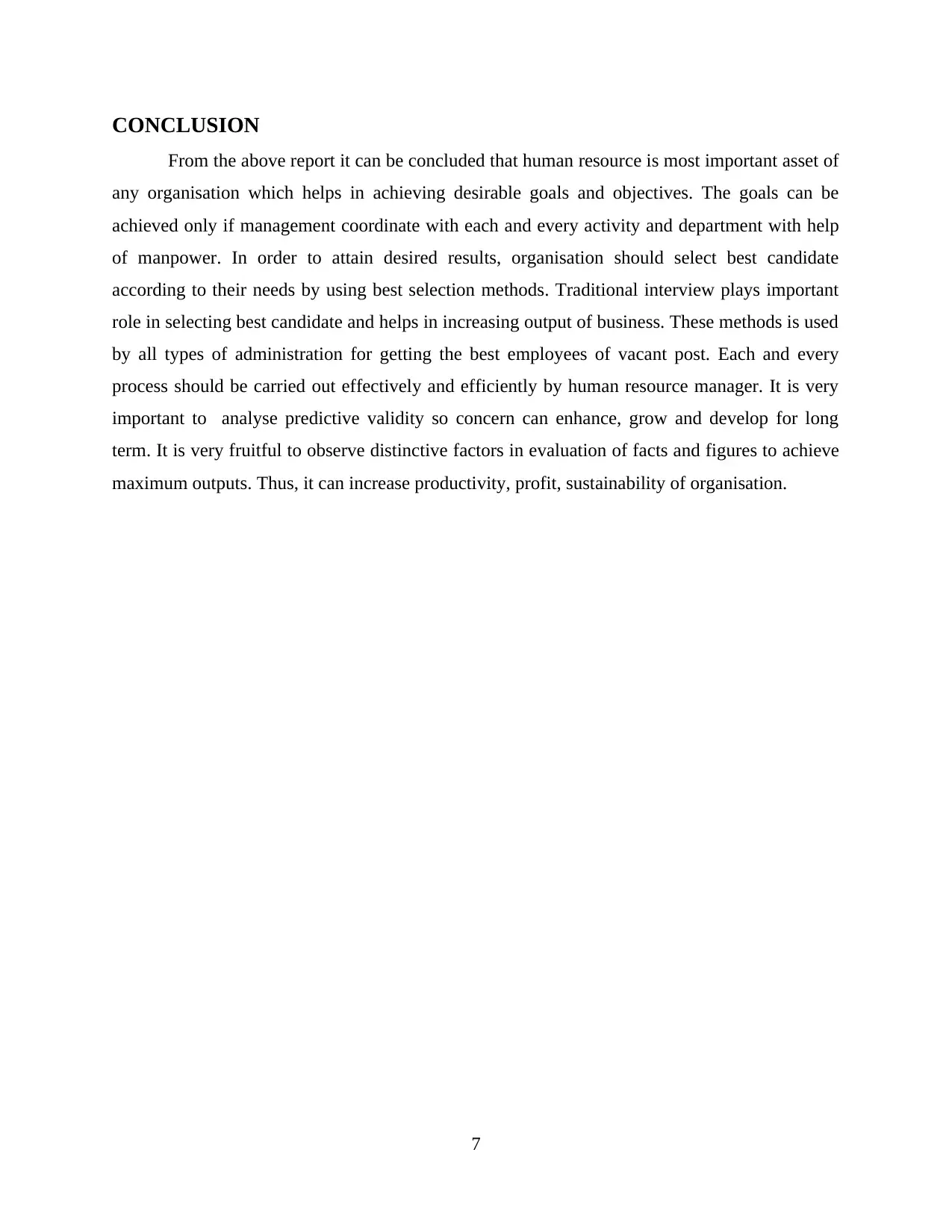
CONCLUSION
From the above report it can be concluded that human resource is most important asset of
any organisation which helps in achieving desirable goals and objectives. The goals can be
achieved only if management coordinate with each and every activity and department with help
of manpower. In order to attain desired results, organisation should select best candidate
according to their needs by using best selection methods. Traditional interview plays important
role in selecting best candidate and helps in increasing output of business. These methods is used
by all types of administration for getting the best employees of vacant post. Each and every
process should be carried out effectively and efficiently by human resource manager. It is very
important to analyse predictive validity so concern can enhance, grow and develop for long
term. It is very fruitful to observe distinctive factors in evaluation of facts and figures to achieve
maximum outputs. Thus, it can increase productivity, profit, sustainability of organisation.
7
From the above report it can be concluded that human resource is most important asset of
any organisation which helps in achieving desirable goals and objectives. The goals can be
achieved only if management coordinate with each and every activity and department with help
of manpower. In order to attain desired results, organisation should select best candidate
according to their needs by using best selection methods. Traditional interview plays important
role in selecting best candidate and helps in increasing output of business. These methods is used
by all types of administration for getting the best employees of vacant post. Each and every
process should be carried out effectively and efficiently by human resource manager. It is very
important to analyse predictive validity so concern can enhance, grow and develop for long
term. It is very fruitful to observe distinctive factors in evaluation of facts and figures to achieve
maximum outputs. Thus, it can increase productivity, profit, sustainability of organisation.
7
Paraphrase This Document
Need a fresh take? Get an instant paraphrase of this document with our AI Paraphraser
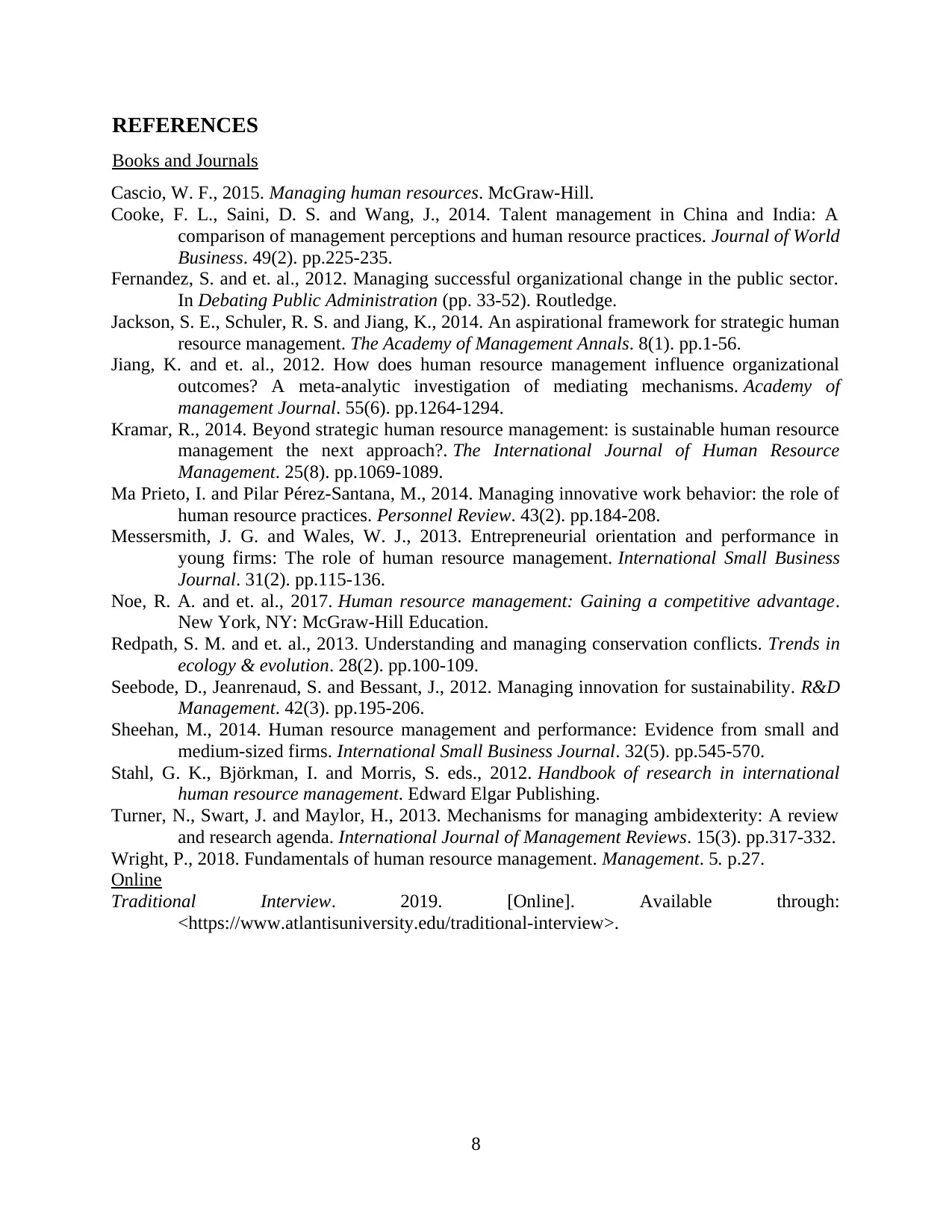
REFERENCES
Books and Journals
Cascio, W. F., 2015. Managing human resources. McGraw-Hill.
Cooke, F. L., Saini, D. S. and Wang, J., 2014. Talent management in China and India: A
comparison of management perceptions and human resource practices. Journal of World
Business. 49(2). pp.225-235.
Fernandez, S. and et. al., 2012. Managing successful organizational change in the public sector.
In Debating Public Administration (pp. 33-52). Routledge.
Jackson, S. E., Schuler, R. S. and Jiang, K., 2014. An aspirational framework for strategic human
resource management. The Academy of Management Annals. 8(1). pp.1-56.
Jiang, K. and et. al., 2012. How does human resource management influence organizational
outcomes? A meta-analytic investigation of mediating mechanisms. Academy of
management Journal. 55(6). pp.1264-1294.
Kramar, R., 2014. Beyond strategic human resource management: is sustainable human resource
management the next approach?. The International Journal of Human Resource
Management. 25(8). pp.1069-1089.
Ma Prieto, I. and Pilar Pérez-Santana, M., 2014. Managing innovative work behavior: the role of
human resource practices. Personnel Review. 43(2). pp.184-208.
Messersmith, J. G. and Wales, W. J., 2013. Entrepreneurial orientation and performance in
young firms: The role of human resource management. International Small Business
Journal. 31(2). pp.115-136.
Noe, R. A. and et. al., 2017. Human resource management: Gaining a competitive advantage.
New York, NY: McGraw-Hill Education.
Redpath, S. M. and et. al., 2013. Understanding and managing conservation conflicts. Trends in
ecology & evolution. 28(2). pp.100-109.
Seebode, D., Jeanrenaud, S. and Bessant, J., 2012. Managing innovation for sustainability. R&D
Management. 42(3). pp.195-206.
Sheehan, M., 2014. Human resource management and performance: Evidence from small and
medium-sized firms. International Small Business Journal. 32(5). pp.545-570.
Stahl, G. K., Björkman, I. and Morris, S. eds., 2012. Handbook of research in international
human resource management. Edward Elgar Publishing.
Turner, N., Swart, J. and Maylor, H., 2013. Mechanisms for managing ambidexterity: A review
and research agenda. International Journal of Management Reviews. 15(3). pp.317-332.
Wright, P., 2018. Fundamentals of human resource management. Management. 5. p.27.
Online
Traditional Interview. 2019. [Online]. Available through:
<https://www.atlantisuniversity.edu/traditional-interview>.
8
Books and Journals
Cascio, W. F., 2015. Managing human resources. McGraw-Hill.
Cooke, F. L., Saini, D. S. and Wang, J., 2014. Talent management in China and India: A
comparison of management perceptions and human resource practices. Journal of World
Business. 49(2). pp.225-235.
Fernandez, S. and et. al., 2012. Managing successful organizational change in the public sector.
In Debating Public Administration (pp. 33-52). Routledge.
Jackson, S. E., Schuler, R. S. and Jiang, K., 2014. An aspirational framework for strategic human
resource management. The Academy of Management Annals. 8(1). pp.1-56.
Jiang, K. and et. al., 2012. How does human resource management influence organizational
outcomes? A meta-analytic investigation of mediating mechanisms. Academy of
management Journal. 55(6). pp.1264-1294.
Kramar, R., 2014. Beyond strategic human resource management: is sustainable human resource
management the next approach?. The International Journal of Human Resource
Management. 25(8). pp.1069-1089.
Ma Prieto, I. and Pilar Pérez-Santana, M., 2014. Managing innovative work behavior: the role of
human resource practices. Personnel Review. 43(2). pp.184-208.
Messersmith, J. G. and Wales, W. J., 2013. Entrepreneurial orientation and performance in
young firms: The role of human resource management. International Small Business
Journal. 31(2). pp.115-136.
Noe, R. A. and et. al., 2017. Human resource management: Gaining a competitive advantage.
New York, NY: McGraw-Hill Education.
Redpath, S. M. and et. al., 2013. Understanding and managing conservation conflicts. Trends in
ecology & evolution. 28(2). pp.100-109.
Seebode, D., Jeanrenaud, S. and Bessant, J., 2012. Managing innovation for sustainability. R&D
Management. 42(3). pp.195-206.
Sheehan, M., 2014. Human resource management and performance: Evidence from small and
medium-sized firms. International Small Business Journal. 32(5). pp.545-570.
Stahl, G. K., Björkman, I. and Morris, S. eds., 2012. Handbook of research in international
human resource management. Edward Elgar Publishing.
Turner, N., Swart, J. and Maylor, H., 2013. Mechanisms for managing ambidexterity: A review
and research agenda. International Journal of Management Reviews. 15(3). pp.317-332.
Wright, P., 2018. Fundamentals of human resource management. Management. 5. p.27.
Online
Traditional Interview. 2019. [Online]. Available through:
<https://www.atlantisuniversity.edu/traditional-interview>.
8
1 out of 11
Related Documents
Your All-in-One AI-Powered Toolkit for Academic Success.
+13062052269
info@desklib.com
Available 24*7 on WhatsApp / Email
![[object Object]](/_next/static/media/star-bottom.7253800d.svg)
Unlock your academic potential
Copyright © 2020–2025 A2Z Services. All Rights Reserved. Developed and managed by ZUCOL.





